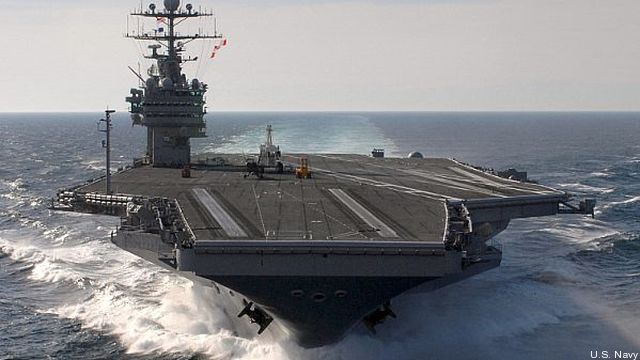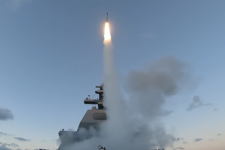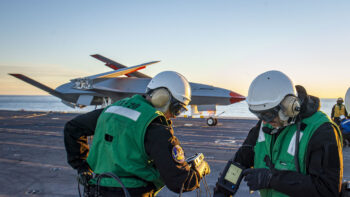
Chinese aircraft, missile, and radar ranges over the South China Sea. (Graphic by Center for Strategic & International Studies) (Click to expand)
Last year, Acting Defense Secretary Shanahan predicted that the Pentagon’s 2020 budget would be a “masterpiece” that fully implemented the 2018 National Defense Strategy. Experts may disagree about whether the actual budget constitutes a masterpiece, but there is no question it takes significant steps to move the department from a focus on regional conflicts and counter-insurgency to a focus on great power conflicts.
But the four services clearly are struggling with this balance. While the strategy clearly calls for a focus on capability, the services still must operate in the day-to-day world where combatant commanders and senior officials direct a high level of deployments to respond to crises, reassure allies, provide humanitarian relief, and conduct ongoing operations, including those against terrorists and other threats. Here are the choices that each service made.
Army.
The Army’s FY 2020 force structure plan is dominated by its reduced end strength goals.
Similar end strength reductions occurred in the National Guard and the Army Reserve.
| FY 2020 goal in FY 2019 budget | FY 2020 goal in FY 2020 budget | Change | |
| Army National Guard | 343,500 | 336,000 | -7,500 |
| Army reserve | 199,500 | 189,500 | -10,000 |
Despite these reductions, the number of major units is unchanged — 31 BCTs in the regular Army, 27 BCTs in the National Guard—but Army budget documents refer to “increases in artillery, air defense, intelligence, and engineer force structure.” The decrease in personnel and the increase in the number of units means that units will become undermanned, contrary to the Army’s plan to overman units. Building new kinds of units for the new strategy will also be difficult and, indeed, the budget does not propose any beyond completion of the earlier plan to field five security force assistance brigades.
One might imagine that the new strategy drove this end strength reduction, since many strategists have proposed trading Army end strength for modernization. The Obama administration, for example, proposed cutting the regular Army to 450,000 and had considered cuts to 420,000.
However, it appears the Army is having difficulty recruiting enough new soldiers and that is the driver. The regular Army fell 7,500 soldiers short in fiscal 2018 and could not recover. There was no point in asking for soldiers that it could not recruit. Army Chief of Staff Gen. Mark Milley still argues that the Army needs to get larger to meet its many global commitments, and the budget documents point out that the Army is very busy, with 179,000 soldiers deployed in more than 140 countries. In theory, the service’s goal is still to field 500,000, but that has been pushed off into the never-never land of the “out years”. So the tension between capability and capacity continues in the Army. In the end, recruiting and the size of the budget may be the drivers.
Longer-term, Army force structure will change as a result of the many changes in RDT&E that the Army made in its “night court” sessions. In this process, the senior leadership moved about $5 billion a year towards new capabilities driven by the national defense strategy. However, these new capabilities will not move into the force until about 2023 or 2024.
Navy.
The FY 2020 budget captures the Navy in transition between two force structure assessments, that of 2016 and a future assessment that the Navy is conducting, due out in late 2019. This transition is expected to shift the balance of the Navy from a focus on carriers to a focus on distributed lethality and unmanned capabilities, and this budget appears to begin that transition.

USS Harry Truman
The 2016 assessment came out just after the Trump election, increasing the target fleet size from 308 ships under the Obama administration to 355, thus making the Navy’s goals consistent with those of the newly elected president, who had pledged a 350-ship Navy. This fleet was to be an expanded version of the existing fleet, with 12 aircraft carriers, 104 large surface combatants (cruisers and destroyers), 38 amphibious ships, and 66 attack submarines. There were no unmanned ships.
Analyses over the last two years have pointed out that growing the fleet of 355 ships would be difficult without a large budget increase and that, consequently, the expansion might not be achievable. In the most recent 30-year shipbuilding plan, the Navy responds to this challenge by proposing to extend the life of existing ships— especially DDG-51 destroyers—and by assuming a large increase in shipbuilding funds outside the FYDP. This achieves 355 ships in the 2030s and then maintains that level into the future.
In 2018 and 2019 budgets the Navy increased production of its existing ship types, buying more destroyers and submarines especially. Future ships were to be improved versions of current ships. It proposed buying a new frigate to replace the disappointing LCS-class, an amphibious LSD class that was a version of the existing San Antonio-class LPDs, and, in the future, a new cruiser class.
The 2020 budget makes several significant breaks with this plan. Most controversial is the decision to retire an aircraft carrier early (USS Harry S Truman CVN- 75). Carriers have long been criticized for their high cost and increasing vulnerability to long-range precision fires. Indeed, the Chinese have built a long-range missile, the DF-21, specifically to take out carriers. The short range of the carriers’ F-18 and F-35 aircraft, about half what the F-15 and A-6 aircraft of the 1980s could achieve, has exacerbated this vulnerability.
Fighting the early retirement are traditionalists, who argue that the carrier continues to be the premier naval capability, and the industrial base, which wants to continue producing an existing system. The Navy’s procurement of two Ford-class carriers gave mixed the signals since it seemed to be doubling down on aircraft carriers at the same time it was retiring a carrier early. Watch for congressional action that may upend the Navy’s carrier plans.
Other elements of the shipbuilding plan offered similar mixed signals.
- It procures two unmanned surface ships in 2020 and two every year thereafter—a radical change—and a lot of unmanned subsurface systems. These are funded in the RDT&E appropriation, in recognition of their experimental status. Indeed, the Navy notes in the 30-year shipbuilding plan that, although these capabilities are included in wargames and capability assessments, there is still much to learn about how such ships would operate in the real world and, therefore, a thorough evaluation is needed before they substitute for manned, battle force ships.
- It eliminates the previously planned LSD replacement ship in fiscal 2020 (LXR or LPD Flight II) so the first ship of that class would not be procured until 2024. It’s not clear whether this indicates merely a resource driven decision—the 2020 shipbuilding budget buys another submarine instead—or whether it indicates a different approach to amphibious warfare, one that does not focus on procuring a small number of extremely capable but expensive ships, but instead procures a larger number of less expensive ships that could be more widely distributed.
- It delays the new cruiser to outside the FYDP, seeming to indicate a lack of commitment, but the Chief of Naval Operations says that a large surface combatant is still needed. This year, as in previous years, the Navy proposes retiring the old Ticonderoga–class cruisers rather than upgrading them.
The battle force ship count continues to increase, reaching 301 in 2020 and 314 by FY 2024, as previously funded ships are delivered. Personnel increase by 5,100 to 340,500 (active duty strength) to man these ships, and, unlike the 2019 plan, which leveled off at 344,800, the FY 2020 plan rises to 354,000. Bottom line: the Navy is serious about manning a larger fleet.
Aircraft modernization continues as previously planned, foreshadowing no major changes to force structure: 30 F-35s (all types) and 24 F- 18s, continuing the Navy’s long-standing strategy of buying both fourth-plus and fifth-generation aircraft; six E-2D Hawkeyes, six P-8A Poseidons, six CH-53K heavy-lift helicopters and 10 CMV-22 Ospreys for onboard delivery. The Navy’s tepid interest in unmanned aircraft also continues, with only five procured (two MQ-4C Tritons and 3 MQ-9A Predators for the Marine Corps). However, the MQ-25 continues to move forward after last year’s contract award to Boeing, with prototypes produced in the FYDP period and production after that.
Marine Corps.
The Marine Corps made a decision years ago to limit its growth, despite some proposals to grow to 190,000 or even to the 200,000. The 2020 budget, therefore, poses growth to only 186,200 with eventual growth to 186,400, the same plan as last year. There are minor personnel increases to Marine special forces and some internal push-arounds, but the focus is on readiness and modernization.
Air Force.
Like the Navy, the Air Force is sending mixed messages. A few years ago, its strategy was clear: buy fifth-generation aircraft and limit fourth-generation legacy aircraft, even at the cost of a smaller force. Two problems intruded, however: the need to meet a wide variety of demands for airpower, and continuing problems with the F-35. This year it seems to take a more balanced approach.

F-15
One element of the balance is the continuing growth of personnel, with total force end strength planned to grow by 4,400, to 511,000. This growth, now in its fifth year, reflects readiness concerns that the Air Force had cut too many personnel in the past. It also reflects abandonment of an earlier strategy to trade personnel savings for modernization. Although Air Force budget documents still call for a 386-squadron force—a 25 percent expansion—that is not reflected in the budget. (And the Air Force leader who pressed hardest for that expansion, Heather Wilson, is leaving the building.)
The balance is seen especially in acquisition. Procurement of the F-35 holds at 48 per year, below the 56 funded by the Congress in 2019 but at the level previously requested by the Air Force, and does not grow to the previous target of 60 per year. Instead, the Air Force proposes to buy eight F-15EXs, the most current version of the multi-mission F-15. This has been controversial in airpower circles, with many criticizing the shift as a step backward. However, it makes the Air Force comparable to the Navy, which has procured both fourth-plus generation and fifth-generation aircraft and as a result avoided the fleet aging and inventory shortfall that the Air Force suffers from. There are also operational synergies between the F-15EX and F-35, as well as some value in having a variety of capabilities so that any problems in one system, like the F-35, do not cripple an entire fleet.
The Air Force continues to flirt with the Light Attack aircraft program, indicating some interest, but not making a commitment through actual procurement.
The budget proposes buying only 12 MQ-9 reaper aircraft, reflecting that system’s limited use in great power conflicts, and, one hopes, additional UAV/RPV procurements in the black world. Having been a leader in unmanned aerial operations, the Air Force needs to retain that lead.
The Air Force also continues the nuclear modernization program, most of which was laid out during the Obama administration. Thus, the still-secret B-21 continues development at $3 billion, the Ground-Based Strategic Deterrent increases its funding from $414 million in FY 2019 to $570 million in 2020. Nuclear modernization, in general, has become controversial with the Democrats in the House, and those elements that were not part of the Obama program, such as the Long-Range Standoff Weapon, funded at $713 million, will be particularly vulnerable. At some point, these acquisition decisions will ripple down to force structure changes.
Civilians.
The major news for DOD civilians is that their numbers will keep growing, notwithstanding an administration that has been skeptical about “federal bureaucrats”. The goal for 2020 is 757,800, an increase of 5,200 from 2019. The Pentagon has been able to justify this expansion, not just in 2020 but consistently over the last several years, by arguing that civilians are an element of readiness. Indeed, most civilians are out in the field supporting troops and maintaining equipment, and not in the Pentagon clogging up the Beltway. One piece of bad news: the budget proposes a pay freeze for civilians in 2020 and higher retirement contributions.
Looking ahead.
The large budget increase in 2020—4.9 percent over 2019—allows the services to afford both modest force structure growth and a robust modernization program. This may not be sustainable in light of rising skepticism among Democrats. Indeed, we may have reached “peak defense.” If so, the miltiary’s force structure tradeoff will not be between slow growth and moderate growth, but between stability and shrinkage.
Lockheed wins competition to build next-gen interceptor
The Missile Defense Agency recently accelerated plans to pick a winning vendor, a decision previously planned for next year.


























